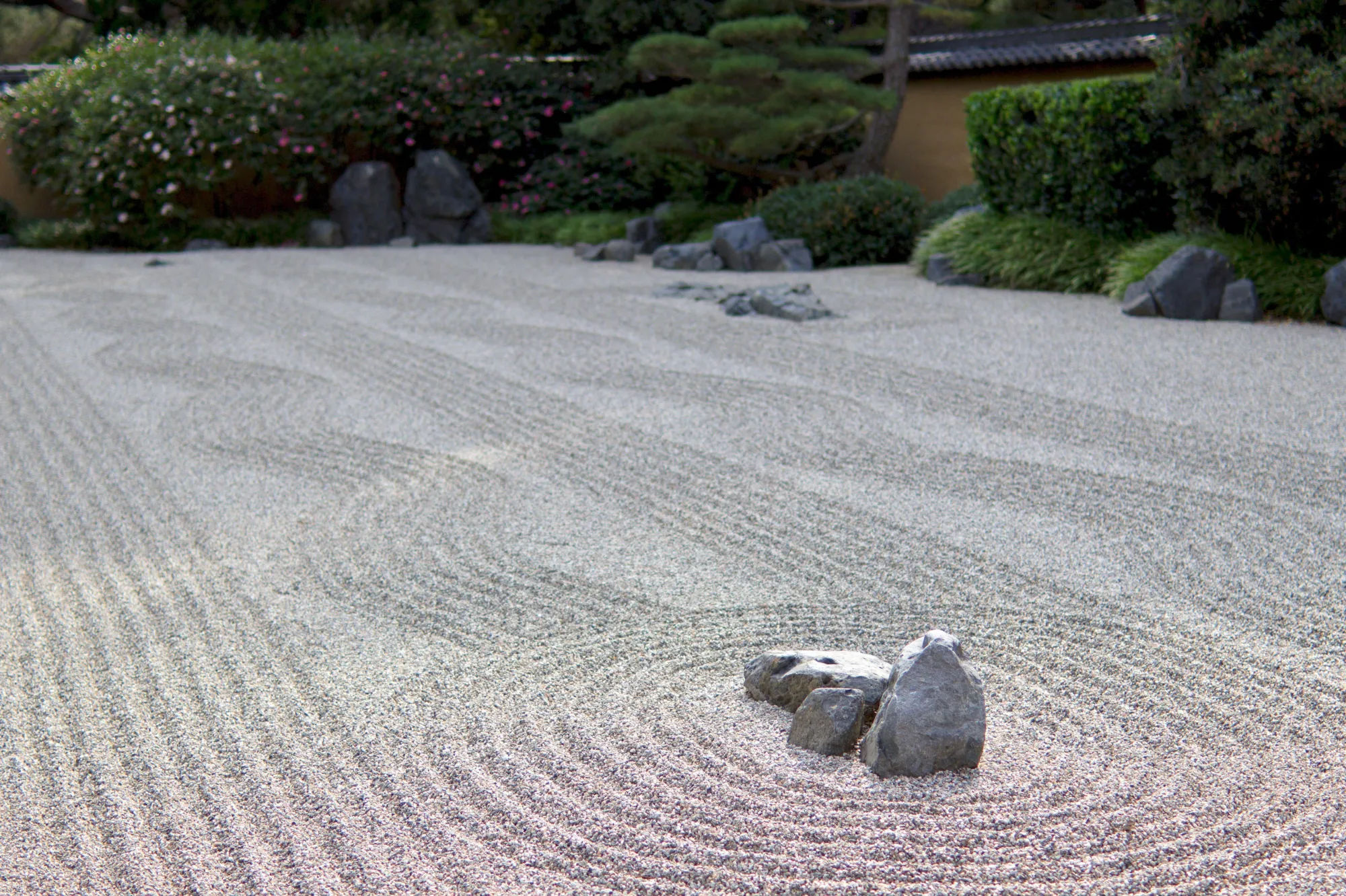

Are you feeling calmer already? For inspiration and instruction, we turn to Sakuteiki, the 11th-century Japanese garden design manual that describes how to create the harmonious, controlled landscape of a dry rock garden.
Are you feeling calmer already? For inspiration and instruction, we turn to Sakuteiki, the 11th-century Japanese garden design manual that describes how to create the harmonious, controlled landscape of a dry rock garden.
The only thing missing is the water.
The only thing missing is the water.
Karetaki: Dry Waterfalls
Karetaki: Dry Waterfalls
Photograph via Wikimedia.
Photograph via Wikimedia.
“Typically the waterfall is represented by standing bluestone lengthwise to symbolize the cascade,” notes the Dictionary of Japanese Architectural and Art Historical Terminology.
“Typically the waterfall is represented by standing bluestone lengthwise to symbolize the cascade,” notes the Dictionary of Japanese Architectural and Art Historical Terminology.
The dry rock garden at Kennin-ji, the oldest Zen temple in Kyoto. To make the job easier, use the right tool; see 10 Easy Pieces: Gravel and Sand Rakes.
The dry rock garden at Kennin-ji, the oldest Zen temple in Kyoto. To make the job easier, use the right tool; see 10 Easy Pieces: Gravel and Sand Rakes.
Photograph by Kimubert via Flickr.
Photograph by Kimubert via Flickr.
Karenagare: Raked Sand
Karenagare: Raked Sand
Karesansui: Rock Sculptures
Karesansui: Rock Sculptures
In Zen gardens, the shape and placement of rocks is a key design component. Rocks also can evoke five natural elements, including:
In Zen gardens, the shape and placement of rocks is a key design component. Rocks also can evoke five natural elements, including:
Photograph by Rassil via Flickr.
Photograph by Rassil via Flickr.
At the Ginkaku-ji Zen garden in Kyoto. Gravel shaped into conical forms can represent mountains, in the style of a giant cone of sand at Ginkaku-ji Temple that represents Mt. Fuji (and spawned centuries of imitators).
At the Ginkaku-ji Zen garden in Kyoto. Gravel shaped into conical forms can represent mountains, in the style of a giant cone of sand at Ginkaku-ji Temple that represents Mt. Fuji (and spawned centuries of imitators).
Photograph by Kimon Berlin via Flickr.
Photograph by Kimon Berlin via Flickr.
Kogetsudai: Gravel Mountains
Kogetsudai: Gravel Mountains
Moss
Moss
Photograph by Kate Nevens via Flickr.
Photograph by Kate Nevens via Flickr.
Low-growing mounds of shade-loving moss at the edge or surrounded by a sea of raked gravel create a peaceful green contrast to the other natural elements in Zen garden.
Low-growing mounds of shade-loving moss at the edge or surrounded by a sea of raked gravel create a peaceful green contrast to the other natural elements in Zen garden.
Trees and shrubs, often placed singly as or along a perimeter of a Zen garden, often are evergreen to create a year-round complement to the other elements.
Trees and shrubs, often placed singly as or along a perimeter of a Zen garden, often are evergreen to create a year-round complement to the other elements.
Photograph by Mihoyo Fuji via Flickr.
Photograph by Mihoyo Fuji via Flickr.
Evergreens
Evergreens
Pick a Perspective
Pick a Perspective
Design your Zen garden to viewed from a single perspective. Sit in a chair and survey the plan—is it pleasing at eye level?
Design your Zen garden to viewed from a single perspective. Sit in a chair and survey the plan—is it pleasing at eye level?
Photograph by el_ave via Flickr.
Photograph by el_ave via Flickr.
The gardens at the Huntington in San Marino, California include a dry Japanese landscape garden. At the edge of a Zen garden, evergreen conifers are often trained as topiaries.
The gardens at the Huntington in San Marino, California include a dry Japanese landscape garden. At the edge of a Zen garden, evergreen conifers are often trained as topiaries.
Perimeter of Plants
Perimeter of Plants
Photograph by Dailymatador via Flickr.
Photograph by Dailymatador via Flickr.
Enclose the Garden
Enclose the Garden
“The road to Daisen-in” leads to one of Japan’s most iconic dry gardens in Kyoto. To reinforce the peace and sense of a Zen garden as an orderly, controlled universe an enclosure—typically a fence with a gate—separates it from the outside world.
“The road to Daisen-in” leads to one of Japan’s most iconic dry gardens in Kyoto. To reinforce the peace and sense of a Zen garden as an orderly, controlled universe an enclosure—typically a fence with a gate—separates it from the outside world.
Photograph by Miss Vichar via Flickr.
Photograph by Miss Vichar via Flickr.
Seek Guidance
Seek Guidance
A paperback copy of Sakuteiki Visions of the Japanese Garden: A Modern Translation of Japan’s Gardening Classic is $15.01 at Amazon.
A paperback copy of Sakuteiki Visions of the Japanese Garden: A Modern Translation of Japan’s Gardening Classic is $15.01 at Amazon.


